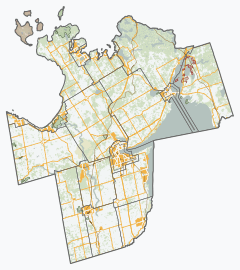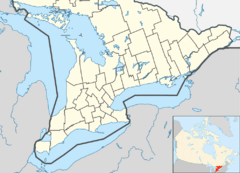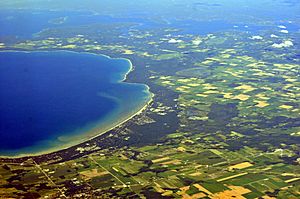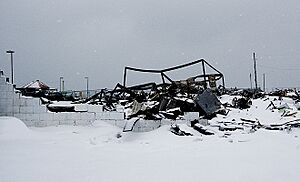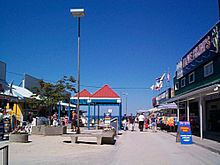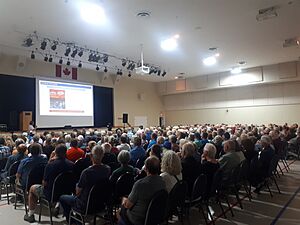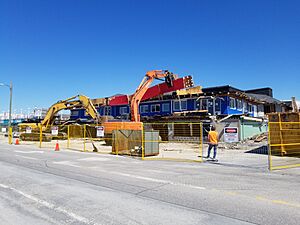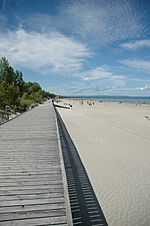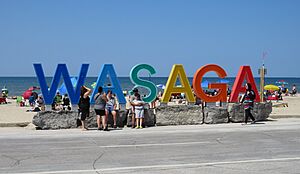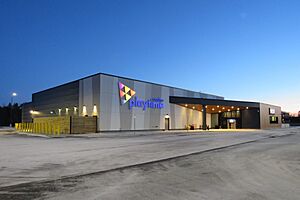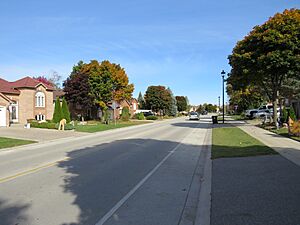Wasaga Beach facts for kids
Quick facts for kids
Wasaga Beach
|
|
|---|---|
|
Town (lower-tier)
|
|
| Town of Wasaga Beach | |
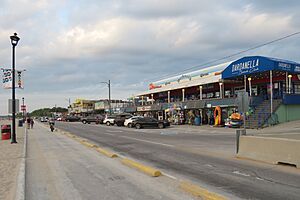
Beach One in August 2024, the final summer before demolition of the beachfront stores for redevelopment
|
|
| Nickname(s):
“The Beach”, “Wasaga”
|
|
| Motto(s):
"More To Explore"
|
|
| Country | Canada |
| Province | Ontario |
| County | Simcoe |
| Incorporated | 1951 (as village) January 1, 1974 (as town) |
| Area | |
| • Land | 58.64 km2 (22.64 sq mi) |
| Population
(2021)
|
|
| • Total | 24,862 |
| • Density | 423.9/km2 (1,098/sq mi) |
| Demonym(s) | Wasaga Beacher, Wasagan |
| Time zone | UTC-5 (EST) |
| • Summer (DST) | UTC-4 (EDT) |
| Forward sortation area |
L9Z
|
| Area code(s) | 705 |
Wasaga Beach (often called Wasaga) is a town in Simcoe County, Ontario, Canada. It's famous for having the longest freshwater beach in the world. This makes it a very popular place for tourists in the summer. Wasaga Beach is located on the southern shore of Georgian Bay. It's about 150 kilometers north of Toronto and 40 kilometers northwest of Barrie. Nearby towns like Collingwood and The Blue Mountains also attract many visitors.
The town sits along a long sandy beach on Nottawasaga Bay. The winding Nottawasaga River also flows through it. The beaches are part of Wasaga Beach Provincial Park. This park covers 168 hectares (415 acres). In 2021, Wasaga Beach had 24,862 people living there all year. But in summer, many more people come to stay.
The town's economy has faced challenges, especially after a big fire in 2007. This fire destroyed many stores. The economy relies a lot on tourists, but the main shopping season is only a few months long. In 2017, the town approved a plan to redevelop the tourist area. This plan aims to improve tourism and make the economy stronger.
Contents
History of Wasaga Beach
For hundreds of years, the Huron-Wendat Nation lived in the Wasaga Beach area. In 1649, the Iroquois Haudenosaunee took over their lands. The name Wasaga comes from the Algonquin word Nottawasaga. Nottawa means "Iroquois" and saga means "mouth of the river". Algonquin scouts used "Nottawasaga" as a warning. It meant Iroquois raiding parties were coming.
In 1812, the United States went to war with Great Britain. Wasaga Beach became an important spot during the War of 1812. It was at the mouth of the Nottawasaga River. This river led to Fort Willow and the Nine Mile Portage. This route was a supply line for British forces. The British ship HMS Nancy was sunk in the Nottawasaga River. This was done to stop Americans from capturing it.
Logging was the main business in the 1800s. Logs were floated down the river to sawmills. Wasaga Beach had sandy soil, which was not good for farming. So, not many European settlers came early on. John Van Vlack was the first permanent settler. He arrived in 1869 and started a settlement. In 1872, a wooden bridge was built to reach the beach. The name Wasaga Beach was first used in the late 1800s.
In the 1900s, families started visiting the beautiful area. The beach became a popular spot for picnics and vacations. The first cottages were built. In 1915, the first beachfront hotel, The Capstan Inn, opened. Later, the Dardanella Dance Hall opened in 1918. More hotels and fun places opened over the years. During the 1940s, soldiers from Base Borden visited Wasaga Beach's amusement park, Playland. This made Wasaga Beach known across Canada. After the war, it stayed popular. However, most attractions closed later. Playland closed in 1985. Two water parks opened that year but closed in the mid-2000s. One was turned into a splash pad.
Wasaga Beach made history in 1934. It was the starting point for the first flight from mainland Canada across the Atlantic Ocean to England. A plane called Trail of the Caribou used the beach as a runway.
Wasaga Beach became a village in 1951. In 1959, the beach became a "Crown beach." This led to the creation of Wasaga Beach Provincial Park. The province bought beachfront properties to create parkland. Driving cars on the beach was once popular. But in 1973, cars were no longer allowed. A paved street, Beach Drive, was built along Beach 1.
Wasaga Beach became a town on January 1, 1974. Its size grew, and the number of people living there increased a lot.
The 2007 Beach One Fire
On November 30, 2007, a large fire destroyed most buildings in the Beach One area. About 17 businesses were affected. These included shops, ice cream places, a restaurant, and an arcade. Nearly 100 firefighters worked for hours to put out the fire. The fire caused about $5 million in damages.
After the fire, the town helped businesses reopen. Plans for new hotels and a theme park were changed. A new development plan was released in 2017.
Local Government
The town is led by a council. It includes a mayor, a deputy mayor, and five councilors. They are chosen by the people in elections.
- Mayor: Brian Smith
- Deputy Mayor: Tanya Snell
- Councillors:
* Joe Belanger * Sasha-Rose Dileo * Faye Ego * Ellen Timms * Richard White
Economic Challenges and New Plans
Even after the big fire, the beach and remaining businesses reopened. The destroyed buildings were old, but people missed them. An entertainment dome was built in 2008 as a temporary solution. It was damaged in a storm in 2011 and later removed.
Plans for rebuilding the area with new shops and hotels did not work out for a while. This was partly due to reduced tourism. Most sales happen during the short summer tourist season.
To help with development, the town bought seven properties in 2015. This included buildings and rental units. The town became a landlord to some businesses. They tried to lease out empty spaces.
The beach is the town's main attraction. Beach areas One and Two are the most popular for tourists. These areas have faced challenges due to the fire and failed development plans. The town has been working on a long-term plan for these important areas.
A new Downtown Development Master Plan was approved in 2017. It's a big plan that will take over 20 years to complete. The first part of the plan involves building in two areas: on the beach and across the river.
In 2018, the town council worked with FRAM Building Group for development. Later, a new council reviewed these plans. FRAM Building Group decided not to be part of the project for a while. However, the Downtown Master Plan stayed in place. The town looked for other developers.
By June 2024, the long-awaited beachfront redevelopment plan was finally approved. Mayor Brian Smith and representatives from FRAM Building Group (who rejoined the project) and Sunray Group of Hotels shared the plans at a public meeting. In 2025, most old buildings along Beach Drive were taken down. Construction for the first phase began in June 2025. This includes new townhomes and shops. A Marriott hotel is planned to start construction in 2026.
Also in 2025, work began to rebuild Beach Drive. The road is being raised 1.5 meters (5 feet) higher than the beach. This will help prevent flooding during high water levels. The road was closed and covered in sand in 2020 due to flooding.
Wasaga Beach Provincial Park
| Wasaga Beach Provincial Park | |
|---|---|
|
IUCN Category II (National Park)
|
|
| Lua error in Module:Location_map at line 420: attempt to index field 'wikibase' (a nil value). | |
| Location | Ontario, Canada |
| Nearest town | Within Wasaga Beach |
| Area | 1,844 ha (7.12 sq mi) |
| Established | 1959 |
| Governing body | Ontario Parks |
Most of the beach is owned and managed by Ontario Parks. It is called the Wasaga Beach Provincial Park. This park includes the famous beach and other natural areas. You can reach Beach Areas 1–6 from Mosley Street. Allenwood and New Wasaga Beaches are east of the Nottawasaga River mouth. You can get to them from River Road East.
The park is for day use only. It covers 1844 hectares. It is home to many birds, especially shorebirds like the endangered piping plover. Besides the beach, there are over 50 kilometers of hiking trails. In winter, these trails are used for cross-country skiing and snowshoeing. The visitor center has access to the Nancy Island Historic Site. This site has a theater, a museum, and a lighthouse.
Fun Things to Do in Wasaga Beach
Over two million people visit Wasaga Beach each summer. They come for the town's freshwater beach, which stretches for 14 kilometers (8.7 miles). People love to swim in the shallow, warm, and clean water. They also enjoy the amazing views of Blue Mountain across the bay.
There are many trails for hiking, cycling, cross-country skiing, and snowmobiling. The Nottawasaga River is great for fishing and canoeing.
The beach is divided into sections, numbered 1 to 6 from east to west. Each section has public park areas, parking, and restrooms. Beaches 2–4 have shade trees, a bike trail, and a playground. Beach 1 is the busiest with bars, shops, and fast food. It attracts mostly young adults. Beach areas 3 to 6 have many seasonal cottages. Shore Lane is used for jogging, biking, and rollerblading. There are two more beaches nearby, New Wasaga Beach and Allenwood Beach. These are separated by the river mouth and also have seasonal residents. The town provides a map of all these areas.
In summer, it's a popular place for beach volleyball and sunbathing. A boardwalk runs along most of Beach 1 and 2. Beach 1 gets the biggest crowds. The beaches become less busy as you go further west.
The water in Nottawasaga Bay helps keep summer temperatures comfortable. In winter, winds from the bay bring heavy snow squalls. Because of the snow, people enjoy snowmobiling, cross-country skiing, and other winter sports. Downhill skiing is available at nearby Blue Mountain. There are many miles of groomed trails for snowmobiling.
Casino Fun
The Playtime Casino Wasaga opened on Mosley Street on November 23, 2022. It was first suggested in 2018. Wasaga Beach was chosen as the location for the casino.
The casino was closed for a short time in 2023. This was because of a cyberattack that affected all Gateway Casinos in Ontario.
Land and Homes
Wasaga Beach covers about 61.13 square kilometers (23.6 square miles). The land is mostly sand. This soil drains water very well. It can be hard to grow lush lawns in town because of the poor soil quality.
Wasaga Beach is also a big "cottage country" town. Many people live there only part of the year. Unlike other cottage areas, most cottages here are not right on the water. They are close together on side streets within the town. Older parts of town feel "woodsy." Newer areas built after 1990 look more like typical suburbs.
Population Growth
| Wasaga Beach Historical populations |
||
|---|---|---|
| Year | Pop. | ±% |
| 1971 | 1,923 | — |
| 1981 | 4,705 | +144.7% |
| 1991 | 6,224 | +32.3% |
| 1996 | 8,698 | +39.7% |
| 2001 | 12,419 | +42.8% |
| 2006 | 15,029 | +21.0% |
| 2011 | 17,537 | +16.7% |
| 2016 | 20,675 | +17.9% |
| 2021 | 24,862 | +20.3% |
In the 2021 Census, Wasaga Beach had a population of 24,862 people. This was a 20.3% increase from 2016. In 2006, Wasaga Beach was one of Canada's fastest-growing communities. Its population grew by 21.0% in five years.
| Canada census – Wasaga Beach community profile | |||
|---|---|---|---|
| 2016 | 2011 | 2006 | |
| Population: | 20,675 (17.9% from 2011) | 17,537 (16.7% from 2006) | 15,234 (21.0% from 2001) |
| Land area: | |||
| Population density: | 352.6/km2 (913/sq mi) | 300.1/km2 (777/sq mi) | 257.2/km2 (666/sq mi) |
| Median age: | 55.3 (M: 54.3, F: 56.2) | 48.8 (M: 47.8, F: 49.9) | |
| Total private dwellings: | 12,516 | 11,645 | 9,938 |
| Median household income: | $62,150 | $54,181 | |
| Notes: Includes corrections and updates. – References: 2016 2011 2006 earlier | |||
Community Buildings
The town has a large community center called the RecPlex. It has an auditorium, an amphitheater, and a YMCA. There is also the Wasaga Stars Arena, which has two hockey rinks. It opened on January 27, 2024, replacing an older rink.
The arena building is also home to the Wasaga Beach Public Library.
Schools in Wasaga Beach
There are four elementary schools in Wasaga Beach: Birchview Dunes Elementary School, St Noel Chabanal Catholic Elementary School, Wasaga Beach Public School, and Worsley Elementary School. The town does not have a high school. Over 760 students take buses to high schools in nearby Stayner, Elmvale, and Collingwood. However, in 2024 and 2025, plans were announced to build two high schools in Wasaga Beach. One will be a public school, and the other a Catholic school.
Getting Around Town
Wasaga Beach Transit
Wasaga Beach Transit provides bus service in the town. It started in 2008 with one route and quickly grew to two routes. Buses run every hour from 7 AM to 8 PM, including weekends and holidays. In November 2023, part of Route 1 became an on-demand service. You need to book this service in advance.
Simcoe County LINX
Simcoe County LINX connects Wasaga Beach to other towns. Route 2 goes to Barrie, and Route 4 goes to Collingwood. You can transfer between LINX and Wasaga Beach Transit buses at the Real Canadian Superstore. LINX has separate fares.
Famous People from Wasaga Beach
- Jason Arnott – An NHL hockey player. He was born in Collingwood and grew up in Wasaga Beach. In 2000, "Jason Arnott Day" was celebrated in Wasaga Beach. This was to honor his Stanley-Cup-winning goal.
See also
- List of communities in Ontario
- List of beaches in Canada


